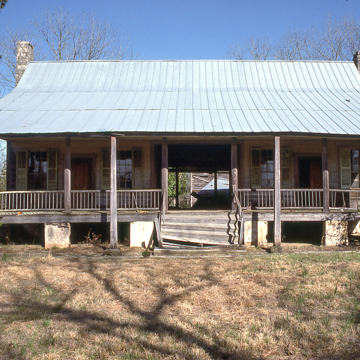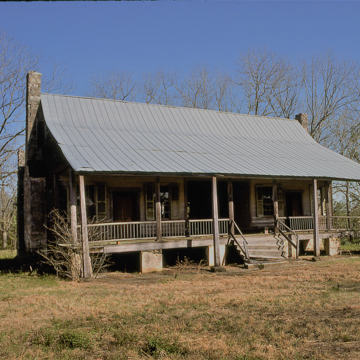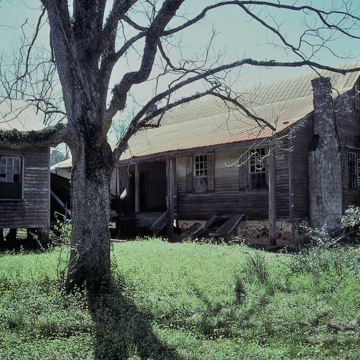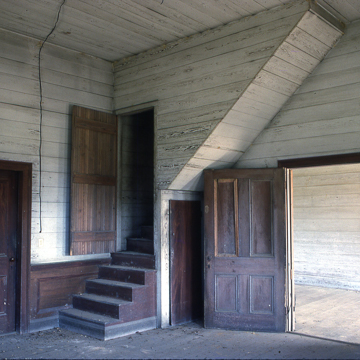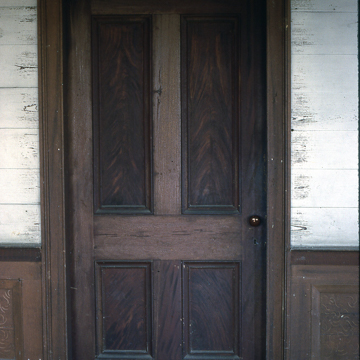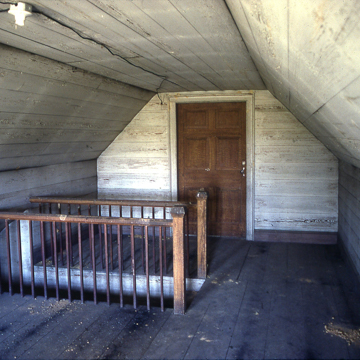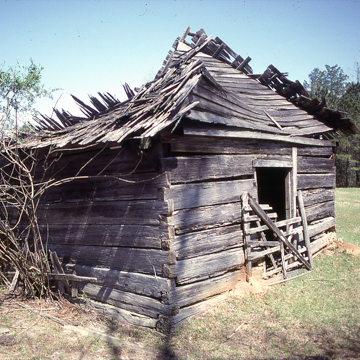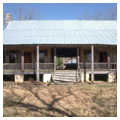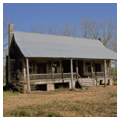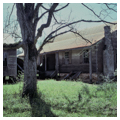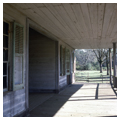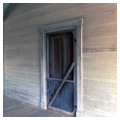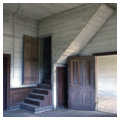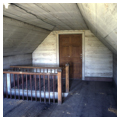Remarkably unaltered since its construction, the Asa Johnston house embodies one of the Southeast’s most distinctive early folk dwelling types, often called the “spraddle-roof house.” Its signature broken-gable roof appeared in versions large and small from the eighteenth century onward, in both town and country, and sheltering families across the social spectrum from slaves and sharecroppers to yeoman farmers, affluent planters, merchants, and professionals.
This house was built for Asa Johnston (1798–1890), a man of wealth and prominence in his community. It stands several miles southeast of the Conecuh County seat of Evergreen. Georgian-born Johnston migrated to Alabama around 1818 at the age of forty-four, bringing his forty slaves with him. He built this residence in 1842 and by the eve of the Civil War, had amassed over three thousand acres of farm and woodland, worked by some sixty-seven bondsmen. Both Asa and his brother Caleb, himself the owner of sixty-eight slaves and whose nearby two-story “I” house stood ruined and abandoned until it finally collapsed in the 1990s, ranked high among the antebellum squirearchy of rural Conecuh County.
Rustic in some respects, unexpectedly refined in others, the character of Johnston’s house suggests much about nineteenth-century rural life in the Deep South, where elegance and rudeness were often found cheek by jowl. Tradition attributes the house’s actual construction to a craftsman transplanted from New England. Born in Connecticut, Ezra Plumb came to Alabama about 1835 and is credited with a number of buildings in the area.
In the Johnston house, the spraddle-roof form is combined with another characteristic feature of the Deep South architectural landscape: a wide breezeway or dogtrot through the middle of the house. This wide, doorless through hall, where the family hounds could always find shelter, was a clever response to a climate in which hot weather often lasted from April through October. Even on the deadliest of mid-summer days, the shady depths of a properly oriented dogtrot passage virtually guaranteed the caress of whatever wind might be stirring. A surprise element of the Johnston dogtrot is its remarkable vaulted ceiling. Whether introduced for aesthetic reasons or, as seems more likely, in the belief that it bestowed further cooling properties, the ceiling has no surviving counterpart anywhere in the state.
Shielding the seven-bay facade is a full-length balustraded veranda, further guarded from heavy downpours and bright sun by a so-called rain porch—a second or supra-porch resting on a series of independent posts set several feet in front of the veranda supports themselves. (A more common variant of this arrangement, the “Carolina porch,” dispenses with the inner row of porch posts and carries the roof on the outer freestanding supports.)
To either side of the broad central dogtrot, double-leaf paneled doors flanked by nine-over-six light windows, originally protected by louvered shutters, open directly into the two lofty main rooms of the house. Behind them, a pair of smaller rooms flank a recessed rear gallery from which a covered way leads to the semi-detached dining room. In early days, the kitchen occupied another, now-vanished building still further to the rear. Both main rooms of the house, sheathed in flush boarding instead of the usual plaster, are handsomely wainscoted and set off with faux mahogany graining. From a corner of the west room a homely enclosed stair climbs to a loft-like half-story overhead.
Only a handful of ruins remain of what was once an extensive group of rustic outbuildings around the main house. Listed on the National Register of Historic Places in 2010, the property remains in the hands of Asa Johnston’s descendants.
References
Cooper, Chip, Robert Gamble, and Harry Knopke. Silent in the Land. Tuscaloosa: CKM Press, 1993.















